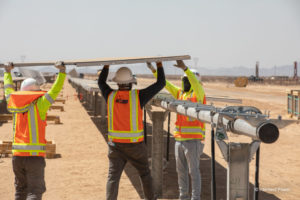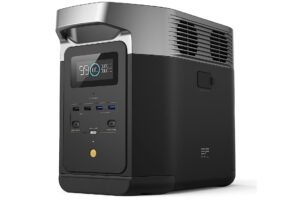Clean energy needs a new bellwether. Who should it be?


Intersect Power’s 224 MWac Athos III solar farm under construction in California. (Courtesy: Intersect Power)
In Episode 75 of the Factor This! podcast, Intersect Power CEO Sheldon Kimber shares why you should forget everything you know about clean energy development. He’s convinced a fresh business model is necessary to sustain an industry battered by rising capital costs. Subscribe wherever you get your podcasts.
Almost by nature, CEOs are deliberate and careful. They tend to offer messages screened for even a hint of controversy; an exercise that neuters commentary of any substance.
And that is why this reporter so gleefully checks in with Sheldon Kimber, an unrestrained clean energy titan who is known to pen a thousand words (or two) on the ebbs and flows of the energy transition. His reflections are not always complimentary of the industry he’s helped build, but they’re rooted in encouraging it to reach new heights.
Don’t be mistaken— Kimber is deliberate, too. He uses his voice not for attention, but because he passionately believes the clean energy industry needs an unashamed advocate.
And few can match his street cred: He built Recurrent Energy into a dominant solar and energy storage developer and then turned his attention to Intersect Power, a fundraising monster that recently turned on one of the largest solar+storage projects in the country.

His latest campaign? Kimber wants you to forget everything you think you know about clean energy development. He’s convinced a fresh business model is necessary to sustain an industry battered by rising capital costs, which have shaken even the likes of sector king NextEra.
Clean energy is in desperate need of a new bellwether- and way of thinking- to survive and thrive. Kimber and Intersect Power say they’re ready to lead the charge.
Escaping the ‘Goldilocks’ business model
I reached out to Kimber, as I often do, for his musings on the clean energy industry’s next move. Crushing interest rates over the past year have shocked nearly every segment, from residential solar to offshore wind.
But I really wanted to talk about NextEra. Long the global leader in deploying clean energy at scale, NextEra Energy Partners, the behemoth’s clean energy yieldco, crashed 65% last fall on poor financial guidance (the stock, while recovering slightly, remains down 43% year-over-year). If NextEra can’t navigate these turbulent financial waters, who can?
Unsurprisingly, Kimber, or at least the team that surrounds him, doesn’t want to discuss NextEra’s situation, specifically. To be sure, NextEra’s investments have been critical to growing the clean energy industry, and the company’s team deserves credit for that effort.
But NextEra’s rise and recent stumble shine an unrelenting light on a business model better suited for a time gone by: one dependent on ever-declining capital costs, record-low interest rates, and financial engineering. Kimber describes it as the “Goldilocks” era, when clean energy developers relied on near-perfect variables to succeed using the “build and flip” strategy.
“It’s not something you want to balance the future of the planet on,” Kimber said on the Factor This! podcast from Renewable Energy World.
Watch the full episode on YouTube
Not a finance guru? Here’s how the industry’s financial model has worked.
A project developer secures a long-term contract from a utility. Because the utility has an investment grade-rated balance sheet and is required to pay for electrons generated by the project, there’s minimal risk to the asset owner. The developer earns more as capital costs decline ahead of commissioning and then flips the project to a yield-hungry pension fund or insurance company.
For the past decade, the model worked. Developers made a killing through development fees. But when interest rates and capital expenditures rise, as they have over the last year or so, “you stall out,” Kimber said.
“As leaders, we need to understand that what we’ve done in the past is just not going to be what drives us forward,” Kimber said. “And, for better or worse, the (Inflation Reduction Act) has put the fate of the planet in the hands of a bunch of ex-bankers and utility executives, like me.”
“I hope we’re up for it.”
Intersect Power was built around the idea that clean energy deployment should cling to growth over low-yield returns. It’s not enough to own assets as an independent power producer only to be hamstrung by long-term contracts, Kimber posits.
Long-term contracts limit risk and provide access to cheap capital, but Intersect Power is realizing the opportunities afforded to those with a higher tolerance for volatility via short-term power purchase agreements.
Intersect Power has built 2.25 GW of projects using an approach accepting more expensive financing and market risk to boost overall revenue.
“If you sensitize for downsides on the market pricing that you’re taking, you still aren’t taking that much more risk,” Kimber said. “The person who’s got the PPA for 16-35 years is still taking an enormous amount of risk. They’re just squinting at it and pretending it’s not there because they’re fully contracted.”
‘Green supermajor’
Even more revolutionary than a fresh look at clean energy financing, though, is Kimber’s vision of what he calls a “green supermajor,” an homage to the multinational oil and gas companies he’s aiming to rival.
Vertically integrated oil and gas companies navigate market volatility because they own upstream and downstream pieces of the value chain. When an upstream business suffers because of price volatility, a downstream business benefits, and vice versa.
In pursuit of “deep decarbonization,” Intersect Power wants to meet the increasing demand for clean, high-capacity factor power where it is. But more than providing onsite power to factories, green fuel producers, EV charging depots, and data centers, Kimber plans to vertically integrate with them.
The idea is for Intersect Power internally to hedge its risk by tapping into both the generation and load sides of the equation, and they’ve already put the plan in motion. The company is developing a green hydrogen facility, and a large data center could be next.
Therein lies the transition to a growth mindset. The model doesn’t rely on low-cost funds. Instead, it embraces a high cost of funds because investors value the growth.
“When you put those two things together, that’s the magic,” Kimber said. “That’s the next generation supermajor. That’s what’s coming.”
Intersect Power’s pursuit of supermajor status could involve public capital markets in the years to come. Kimber said an IPO could be in the works 3-5 years down the road.
Seizing the moment
While some of Kimber’s vision will take years to materialize, there’s no time like the present, and he fears the clean energy industry could risk stunting its growth if doesn’t seize the vast opportunities that exist today.
The Inflation Reduction Act provided unprecedented support and certainty to an industry accustomed to two-year cliff cycles. Still, Kimber bemoans the “whining” he’s heard inside the sector.
Many, he says, believe the Biden administration should be doing more to weaken the blow of high interest rates, not to mention the solar tariff moratorium that expires in June.
“We can’t let (the Biden administration) believe that we’re a bunch of whiners who are going to keep asking for more,” Kimber said. “I think we’re really close to that right now.
“There’s a lot of money in our industry, but yet we still plead poverty when it comes to politics. Our friends in the fossil fuel industry don’t.”

Intersect Power is among the group of clean energy developers sprinting to “Trump-proof” their business, fearful of the impact of a potential change in the White House next year. The company is “very focused on” hedging where appropriate, whether by expediting construction on certain projects or capitalizing on (for now) favorable permitting policies.
But more importantly, Kimber is adamant that industry leaders get involved, and open their wallets, to support the Biden administration through a difficult election year.
“If you take the number that you have in your mind for what you think is reasonable to give to political campaigns, to voter organizations… multiply it by a lot,” he urged.




